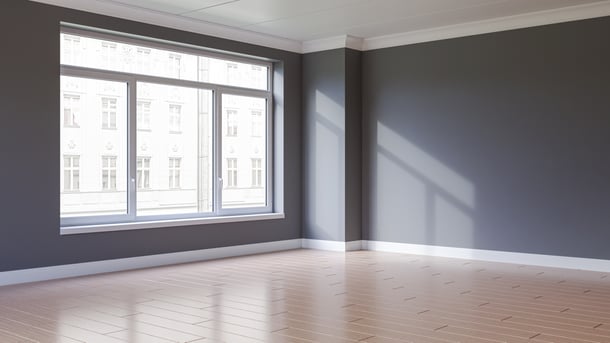
Installing a new floor into an existing space is one of the best ways to increase the value, usability and overall appearance of any room. New flooring can often provide additional benefits like greater comfort, safety and increased levels of cleanliness, depending on the flooring materials you install.
Regardless of the flooring material your customer chooses, as contractors, it is critical to begin with proper surface preparation before you start. Make no mistake about it... surface preparation is the foundation of all beautiful, functional and long-lasting flooring installations. In fact surface preparation is often the key factor between a successful floor install and one that is susceptible to failure in the future.
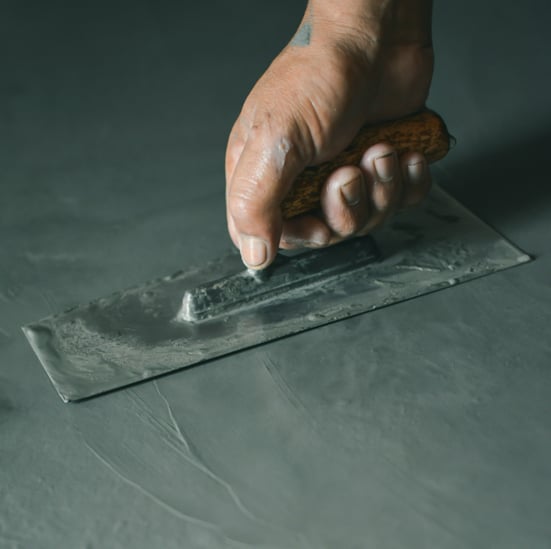
Below, we cover 9 fundamental aspects of surface preparation that you need to consider when installing your new floor successfully...
The 9 Fundamentals of Surface Preparation
- Check for hazardous materials
- Remove existing flooring
- Beware of hidden imperfections
- Watch out for “Telegraphing"
- Check the integrity of your slab or subfloor
- Keep your eyes open for potential moisture issues
- Check the level and flatness of your floor
- Choosing a qualified, knowledgeable subcontractor.
- Don't Cheap out on the wrong prep materials
1 Existing Flooring? Check for Hazardous Materials
Unless you are dealing with an install over newly poured concrete - you are more than likely going to have to remove existing covering from the floor. Before you do that, you'll have to check existing flooring for hazardous material.
In recent years the dangers of hazardous materials in buildings have been brought to the forefront. Materials like Asbestos, led, mercury and silica dust to name some of the more common materials. These contaminants can be anywhere in a facility, in a variety of materials, including FLOOR COVERINGS & MASTICS.
There are a wide variety of laws dealing with the removal and handling of these hazardous materials. As a contractor it's your job to know the local laws and requirements and how they impact your project. Some products are common knowledge within the industry - others might be identifiable with the time period they were manufactured and installed. There are many resources available online that help identify hazardous materials - but there are always exceptions - so be cautious.
The bottom line is - if you are in doubt - test the existing flooring with material testing labs before removing.
do not remove hazardous materials yourself,... you must always use a licensed & bonded abatement contractor. it is very dangerous and financially risky for a untrained contractor to remove hazardous materials.
2 Remove Existing Flooring - Quickly & Easily as Possible
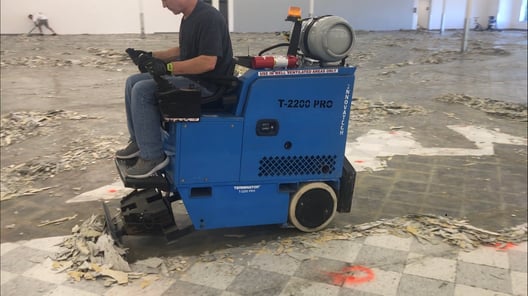
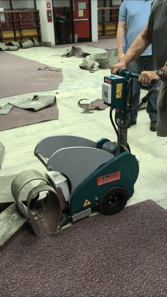
As I stated in the previous paragraph - if its not a new floor, there will be material that must be removed first. There are four main ways that is typically done…
- By Hand with Static Equipment
"Static Equipment" would be tools like prybars, hand scrapers, steel spuds and shovels. This method is often used in residential projects because flooring areas tend to be smaller and not too time consuming when you have many hands available to help you remove and dispose of materials. - By Hand with Power Equipment
There are many power tools available that improve on the performance of a static tool. This is another method that is commonly used in residential projects and in some commercial instances. While these tools help increase productivity - it is often still difficult work as these tools are often heavy and tiring to use over longer periods of time. - Powered Walk-behind Floor Strippers
Walk-behind tools significantly improve the operator experience as well as the overall productivity of the removal. This method is used in both residential and light commercial environments where floor substrates and on cement floors. - Powered Ride on Floor Strippers
Ride-on Floor Strippers (or Floor Scrapers) are the professional standard tool for floor removal. Extremely high productivity with reduced manpower requirements (one man can remove thousands of sq/ft in hours) and a key factor in reducing worker fatigue. These machines are used predominantly in commercial and industrial settings.
FOR MORE INFORMATION ON FLOOR SCRAPERS CLICK HERE

3 Beware of Hidden Imperfections.
“Stretched carpet covers a multitude of sins”… That's what my dad always told me... oftentimes, when walking a project, the floor is clear and exposed and your able to get a good understanding of the amount of floor preparation that will be required to install your product.
Sometimes though, those imperfections are not as noticeable, as with the case of existing stretched carpet over a padding, or fully furnished spaces. anything could be under there from other layers of material that must be removed to slab and foundation cracks and settling problems.
A homeowner or a contractor should always build into your budget potential additional work. Contractors should also make sure that there are potential change order clauses in their contract to address unseen imperfections.
4 “Telegraphing” - Deal with floor imperfections
What does telegraphing mean? In the flooring, coating and painting world “telegraphing” refers to any imperfections in the substrate like ridges, cracks, undulations, seams in the underlayment, even the embossing on old sheet vinyl, weather concrete, wood, sheetrock on walls, anything that “shows through” when coated with paint or materials like Sheet vinyl or VCT flooring are installed... Paint or wallpaper if we are talking about walls... these imperfections take away from the aesthetic appeal of the new flooring. And can cause premature wear of your new flooring.
An example of telegraphing is in the image below, the installer did a substandard prep job, flattening of the floor before the install and coupled with the natural lighting from the windows resulted in a very unacceptable finish.
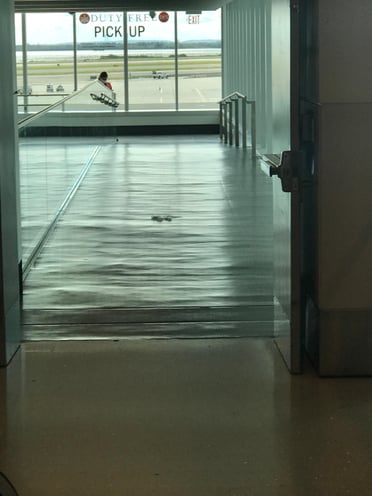
Example of natural light highlighting the imperfections of the surface prep
The evil's of natural light & wax
What is very common on a newly installed floor, coating or paint on a wall is this,... the floor might look great after it is installed and when inspected with normal above lighting (which is the lighting you are supposed to inspect flooring with) but, here is what can happen... when the curtains on windows are opened allowing the… “Natural light”… to flood across the surface of the material installed, like in the image above, it is then that you have a much higher possibility of “Telegraphing” of imperfections in the substrate...
Or, sheet vinyl or VCT might look great and perfectly smooth until... (Flooring installers know what I’m about to say,) until you… WAX… the floor! The shiny wax emphasizes any imperfections causing them to be easily perceivable.
Beware of even subtle imperfections, when I was contracting, my moto on floor prep was this…
“If you can feel it, you will see it”
don’t take shortcuts on smoothing the substrate, don’t have the attitude that... “That’s good enough…probably?” because it is probably not, and you run a real risk of “Telegraphing” imperfections in your substrate.
5 Know the integrity of your subfloor
It is critical that a flooring installer have confidence that the substrate is solid. on concrete it would involve making sure that there is no flaking material on the surface as well as the concrete be solid and not flaking. you must make sure as well that there are no “bond-breakers” on and in the surface like oil, wax, chemicals that will interfere with the bonding of the material to the floor.
Or if for instance you wish to, or must install over an active joint in concrete, it must be understood that that joint WILL move and nothing you do will stop it. So, plan on it, if you’re installing some materials like ceramic tile there are “crack suppression membranes” you can apply, they do not stop the movement but mitigates its effect.
Cense you can't avoid installing over active joints, make sure the end-user is aware of the possibility of developing an imperfection in the floor caused by an active joint and importantly, BEFORE the install!!! this makes the potential for misunderstandings or call-backs for repairs much less likely.
…Here is an example of an active joint…
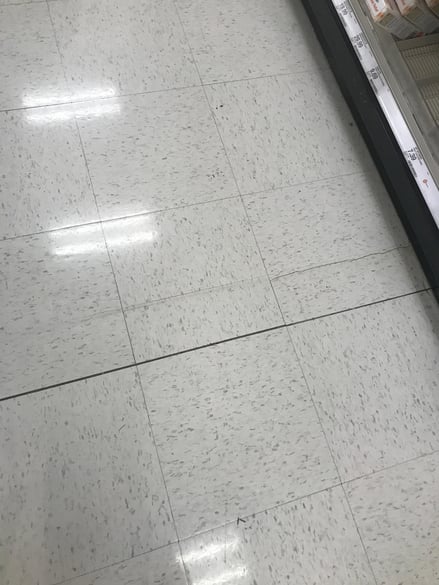
I can guarantee you that the contractor that installed this VCT did not leave it looking like this… when he packed his tools and left the jobsite these tiles were NOT cracked and gaped like you see here. This is an active joint and happened sometime after he left. This is very common and there is just about nothing you can do about it, it is even oftentimes very difficult to identify if a joint is a static or active joint.
6 Address Potential Moisture Issues.
This is an extremely important point in surface preparation, because like active joints we just talked about, you don’t see the effects of moisture in a slab until latter in the life of flooring materials. It can show up as soon as a couple weeks or much farther in the future… But when it does, it will most likely ruin your flooring.
Test for moisture content & material tolerances
Know what the moisture tolerances are for the material you are installing; they are always available from the manufacturer and probably right on the bucket of adhesive you will be using. Remember, get the information for both the material you are installing as well as the mastic you are adhering it to the floor with.
How do you determine the moisture content of the slab? There are a couple common ways of doing this that I would recommend and one I would not..
- Calcium Chloride test. This method uses a small tray of pre-weighed moisture absorbing material under a plastic shield taped to the surface of the concrete and weighed again after a set amount of time and the difference in weight gives you the moisture content in the slab.
- In-Slab Relative Humidity test. This involves the drilling if a series of holes in the slab and inserting probes to test for moisture.
- 18”X18” plastic taped to the surface of the concrete. It is a cheap, inaccurate, method that you can use to get a pretty good idea if you have a moisture problem but it does not tell you HOW MUCH of a problem and only gives you an idea of what moisture is close to the surface and manufacturers of both flooring materials, epoxies and mastics will not accept this as an acceptable method of testing for moisture.
…Here is an example of moisture damage…
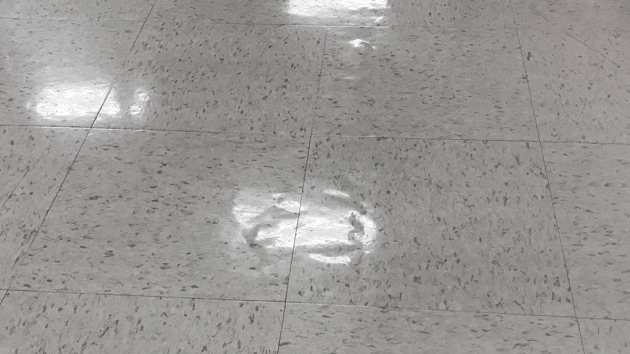
Like the previous image, the flooring contractor did not leave this floor looking like this, it happened after he left. It is one of the tell-tell indication of moisture migrating through the slab. These are mineral deposits like Alkali and Salts that are brought along with the moisture, these build up and ruins the flooring.
So… know the moisture content of your slab before installing your flooring material.
7 Level & Flatness - Know your Floor and what is Required
Level is not flat and flat is not level, what does that mean?... Both are important. But, It is important to know what a customer is asking of you, a contractor I knew years ago found this out the hard way…
He was contracted to make a concrete slab LEVEL then install the flooring over it. When he was finished, a very expensive piece of medical equipment (of some kind) was to be installed on top of his flooring, he did a beautiful job installing the very expensive flooring over a professionally FLATTENED floor… and he had to tear it all out! the reason? because he confused flat with level and Level was in the contract.
The lesson I learned watching him deal with this miscommunication is to make sure you understand what is being asked of you when prepping a substrate.
there are gauges for determining how flat and how level a floor is they are the "FF" & "FL" or "floor flatness" and "floor level" as flooring contractors we should know of this gauge of FF & FL so we are able to provide successful installations.
8 Choosing a qualified, knowledgeable subcontractor.
This too, is critical for a successful outcome on your flooring project, if your a general contractor you contract with subcontractors all the time, and already understand the importance of QUALIFYED subcontractors.
You must have the best team of installers on your project to insure a successful outcome. Consider these aspects when choosing the correct specialty contractor…
- Don’t shop price!... It is of course necessary to be conscious of cost but, when has it ever been, that the lowest bid on a project is the correct choice? The answer is NEVER! The best, most qualified contractor would never work for the lowest price. They value their skills and expect to be paid accordingly.
When I was contracting we called it “Plumbing the bottom” cut-rate installers that would go out and “Under-Bid” regular, qualified installers to win the contract, the problem is, it oftentimes worked! But almost always the outcome for the end-user is an inferior installation. Often, after a cheap installer is finished, it can cost the end-user more money to fix the cheap, substandard install than it would have been to have hired the best installer at first, not to mention the hassle of repairing the install, ...if it is reparable, sometimes, the only option is to remove the flooring and install new..
The old adage rings true…You get what you pay for.
9 Choosing the correct prep equipment & material.
Last, it goes without saying that there are a wide variety of surface prep equipment and materials used to prepare the substrate for the flooring material you will be installing... Don't go cheap! use the best...
- High performance mastics and leveling compounds are always far superior to the low-grade, materials.
- High performance, professional machines like ride-on scrapers, diamond grinders and shot-blasters are always better than the cheaper versions of that equipment.
- The best Tooling, always get the professional versions of tools, not the cheap one-time use tooling.
so, there is a lot that goes into a successful flooring project and the correct preparation of the concrete surface is the crucial first step.
if your a contractor with questions about what equipment is best for your surface-preparation projects, contact us here at Bartell Global and one of our knowledgeable team members can get you the information you need. or click below

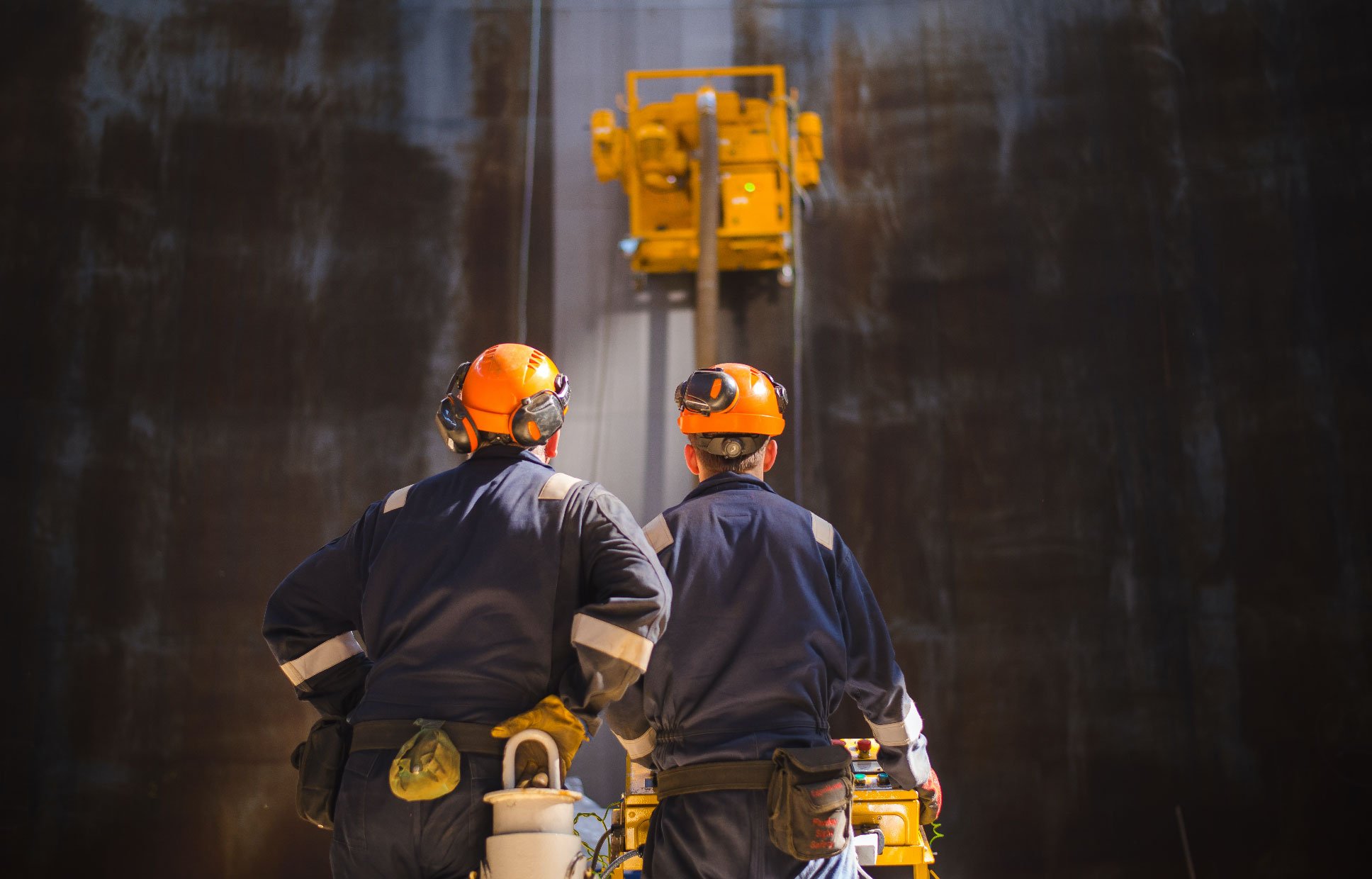
 By
By